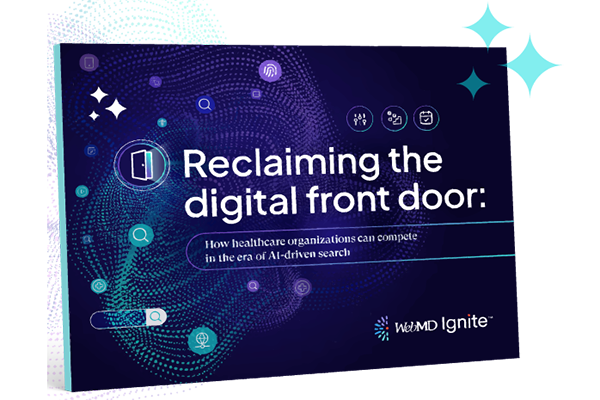Patient engagement FAQ

Editor's Note: This blog was published prior to the transition to WebMD Ignite.
Frequently asked questions: What is patient engagement?
Patient engagement involves encouraging patients to make informed decisions about their own health. Engaged patients are also known as “activated patients,” meaning they engage in positive behavior like managing their own health and care. This helps improve health outcomes and achieve lower costs.
Why is patient engagement important for health systems?
Patients are now starting to weigh their healthcare options in much the same way as they do when buying a car or investing for retirement. They don’t want decisions about their health to be made for them. Rather, they would prefer to learn more about their own health from trusted sources and reach these decisions in conjunction with their physician.
This collaborative approach to healthcare helps health systems build trusted relationships so patients stay invested in their care. In fact, engaged patients are three times less likely to have unmet medical needs, and twice as likely to seek care in a timely manner when compared to unengaged patients.
Benefits of patient engagement
Increased knowledge and understanding encourages patients to become actively engaged in their own health, well-being, and healthcare choices, leading to improved care and fewer ER visits.
In addition to improving care, patient engagement also has financial benefits as it reduces no-shows, aids in increasing revenue, and maintains your patient base.
By collaborating and engaging with patients in the decision-making process, healthcare providers can make better decisions regarding a patient’s health, improving the patient-provider relationship, and overall patient retention.
Physicians are better able to treat patients in the most effective way possible, ultimately becoming more time and cost efficient.
Challenges in enabling better patient engagement
There are both personal and systemic barriers that continue to hinder patient engagement. From the patient side, there is often a hesitancy to be proactive due to a variety of factors. Often, patients do not have the health literacy or digital access required to make informed decisions. Also, certain individuals may be less likely to engage due to their level of education, age, sex, religious beliefs, or cultural values.
Health systems must keep these factors in mind when crafting their engagement strategies to ensure all patients have confidence in their decisions. There are also systemic issues on the provider side. The traditional health system is not set up to facilitate patient engagement, whether it be from a facility’s design to a lack of advanced technology. Additionally, physicians may not have the time or training required to properly engage patients in their own care, leading to non-compliance with treatment plans and suboptimal outcomes.
Strategies for improving patient engagement in healthcare
There are a few strategies you can deploy in order to encourage patient engagement. Let’s take a look at four of these strategies and how they can impact the health system.
Personalizing interactions
In the modern market, customers expect all types of businesses to understand their individual wants and needs. This is particularly true in the healthcare industry, as the services provided are deeply personal. Thus, personalization is essential to patient engagement; if you don’t know personal attributes about your patients, your engagement strategy is going to be basic and ineffective.
With the use of customer journey maps and marketing technology, healthcare can create deeply personalized engagement plans at scale: right patient, right message, right time.
Integrating technology
Use electronic health records (EHR) and a healthcare customer relationship management (CRM) platform to collect, organize, and analyze patient data such as demographics, psychographics, social media activity, behavioral patterns, clinical history, call center interactions, and provider credentialing. These technologies work together to generate 360-degree views of patients, giving healthcare organizations the insights necessary to deploy patient engagement efforts effectively.
Another technology necessary for patient engagement is a marketing automation tool, which automates outreach to create a continuous patient engagement journey. With marketing automation, healthcare organizations can execute structured patient engagement through channels like email, direct mail, and social media text easily and cost-effectively.
Healthcare organizations should also integrate their call center software with their CRM. With an engagement center, since it integrates with other marketing technologies, representatives are able to have relevant and carefully crafted conversations with patients that increase engagement.
With EHR, CRM, marketing automation, and engagement center systems in place, healthcare organizations can proactively identify, execute, and measure all types of engagement initiatives to deliver value-based care that is truly patient centric.
Include your physicians
It’s not just healthcare marketers that play a role in boosting patient engagement; physicians do as well. Physicians that have frequent contact with their patients, that refer their patients in-network, and that provide attentive, thorough care help to increase patient engagement. Getting physicians on board with engagement-focused initiatives is extremely important and can produce excellent results.
Common patient engagement questions
What is the history of patient engagement?
Patient engagement wasn’t always a priority for health systems. In the past, many health systems adhered to a system of medical paternalism, where a physician’s decisions outweighed a patient’s wishes. As the 20th century drew to a close, however, the general public began to gain basic health literacy – and with this knowledge came the desire to control their own medical decisions.
With that said, there is still a large gap in knowledge between the patient and practitioner. Patients may not understand how to make the best health decisions given their preferences, needs, and values. Ongoing engagement is one way to bridge this gap. When providers treat their patients based on training and practical experience, both parties can engage in shared decision making, helping patients become more confident in their own health.
What is the patient engagement journey?
This is the multi-stage process in which the patient interacts with the hospital or health system, ranging from the early education and awareness stage to physician interaction and appointment follow-ups. The phases of the patient engagement journey include the following:
- Awareness: Self-assessment of conditions and symptoms, leading to online research and education, posing questions on social media, etc.
- Help: Initial contact with health system via call center, email, mobile, etc. (i.e., Who do I contact? Where can I find it? How can I ask a proper question?)
- Care: Assessment of health conditions in a medical facility (physician’s office, hospital, etc.)
- Treatment: On-site and follow-up care (medications, physical therapy, etc.)
- Behavioral/Lifestyle Change: Changes to reduce readmissions and promote proactive health.
- Ongoing Care/Proactive Health: Ongoing care management between patient visits, fostering engagement between the patient & physician and enabling the patient to better manage his/her own care.
How has public policy influenced patient engagement initiatives?
Policymakers at the state and federal level have encouraged health systems to create patient engagement strategies. The most prominent example of this is the Affordable Care Act Section 3506, which seeks to incentivize shared decision making between patients and physicians at the federal level. Additionally, the Centers for Medicare & Medicaid Services (CMS) further endorsed patient engagement through their Quality Payment Program.
How can providers improve patient engagement?
Integrating necessary technology is one way providers can enhance their patients’ engagement levels. Health systems can extend the breadth of their EHR by adding and integrating a CRM system, weaving together multiple sources of data (including patient demographics, psychographic, social, behavioral, clinical, call center, and provider credentialing) to provide a more comprehensive view into patient and consumer habits and activities.
Does patient engagement improve outcomes?
Yes. Multiple domestic and international studies have shown that higher patient engagement leads to better health outcomes. The opposite is also true. In fact, according to one study, less engaged patients are three times as likely to have unmet medical needs and twice as likely to delay medical care. By actively engaging patients, especially to those with chronic conditions, health systems reduce the likelihood of costly emergency procedures and help improve overall patient retention.
With a CRM system in place, healthcare organizations can proactively identify, execute, and measure all types of engagement initiatives to deliver value-based care that is truly patient-centric.




